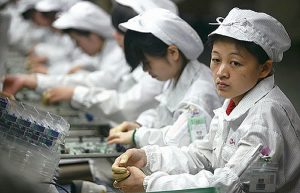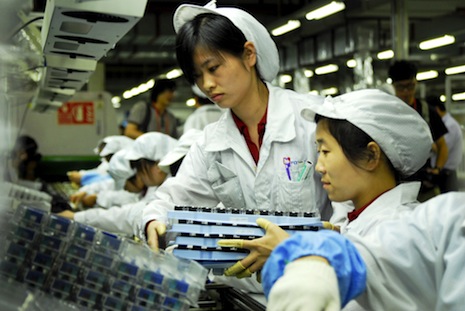Beijing, July 31 (NIA): China, which has a population of 1.35 billion and is the most populous country in the world, is facing a labor shortage for a variety of reasons and may have to throw its doors open to immigrants, says Rong Xiaoqing, in Global Times an organ of the Chinese Communist party.
But Shawn Mahoney, a China business consultant writing in www.manzellareport.com says that there is no real labor shortage and that the apparent shortage is due to the systematic alienation of internal Chinese migrant labor.
However to begin with Rong Xiaoqing, he says: “I’d read a lot about China’s labor shortages before I travelled back to the country recently. I knew it was hard for the manufacturers to find workers to fill their assembly lines now, young people don’t like to do laborious work for low pay anymore, and labor costs have been going up.”
“Still, when I travelled in southern China recently, I was surprised to see labor shortages have affected the details of everyday life for average people. One friend told me she had been trying to hire a nanny for her paralyzed 80-year-old mother but had failed. Both the two nannies she found so far left in weeks for better jobs such as baby sitting. One of them left without even leaving a note.”
“Another friend told me a newly hired secretary at the high-tech company at which she worked, a smart and capable woman in her early 20s, had just quit because, in the former employee’s own words, “it’s hard to catch the crowded bus in the morning.”
“A third story I heard concerned the owner of a small tea shop. A salesgirl at the shop, a fresh high school graduate from a rural village, quit recently because she doesn’t like the fact that the shop only had one other salesgirl and she had no one else to hang out with.
“Then, on a rainy night in Fuzhou city, the taxi driver who drove me back to my hotel, a young man in his early 30s who was originally from a rural area of Sichuan Province, told me that when he first came to the city two years ago, a friend found him a job in construction. But he quit in a few days. “It was well paid, 400 yuan ($60.85) a day, but too tiring. I’d rather work less hard for less money,” the driver, who now makes half the amount, told me.” Rong recalls.
This, in a country that’s been quickly aging, is alarming. As a response, China has decided to raise the retirement age and most recently, repealed the decades long one-child policy, hoping to boost the working and the young population.
Solution
But Rong found a solution. on another trip he discovered at least one solution, which, with or without conscious backing of the government, is happening. Her ealized this when a friend took him to a restaurant in Shuitou, a county in the suburb of Quanzhou city.
“The restaurant is known for its Sichuan-style hotpot. But in the middle of the dining hall it stationed an Indian chef making roti, Indian bread. The roti was adapted for Chinese tastes with some fruit slices inserted in the middle of two thin layers of flour. And clearly part of the chef’s job was to perform for the diners,” he recalls.
“Foreign chefs may not be a rare species in big cities like Beijing or Shanghai. But Shuitou is little known and doesn’t even have a train station. To have a foreign chef working there seems to me an unmistakable sign that China is getting more open to hiring foreign labor.”
The presence of the Indian chef in Quanzhou is part of a wider statistical trend. 848,500 foreigners lived in China in 2013, and the number had been rising at 3.9 percent in the previous decade compared to the 3.0 percent annual growth rate in 1990 to 2000.
Foreigners are still too few and far between in China, Rong observes. They are less than 0.1 percent of China’s population.
Other Asian countries with a labor shortage have already taken advantage of the surplus in neighboring countries. In Singapore, for example, foreign workers do a lot of vital work. Even Japan, a country known for its firm commitment to maintaining its homogeneity, has started to take in a few more foreign workers.
Need For Multi-culturism
Sooner or later, China will have to seriously consider opening its doors wider. But the worrying part is that the Chinese are far from being prepared for a multi-cultural and multi-racial society.
“We will need to learn quickly from any missteps – because there will be some – and work hard to resolve any conflicts quickly,” Rong says.
 Alienation Of Chinese Migrant Workers
Alienation Of Chinese Migrant Workers
Shawn Mahoney writing in www.manzellareport.com feels that the shortage is due to the alienation of Chinese internal migrant workers.
During the last two decades of China’s development, rural workers migrating to urban manufacturing regions have been the chief source of labor According to the Chinese government’s, own statistics, migrant workers have increased to more than 250 million from just over 60 million in the last 20 years. Many non-government organizations place this number at a more realistic 350 to 400 million.
But even with a massive number of workers available nationally, China Daily recently reported that labor shortages are growing worse in cities like Guangzhou and Shanghai. In these areas, there is an estimated 30 to 70 percent gap between the number of workers demanded and the number available.
Chinese news reports also reiterate that an increasing number of workers previously employed on the coast are now actively seeking work in interior provinces closer to their birth counties.
“The hard truth: most migrant workers are no longer incentivized to travel to these cities for employment when they can achieve equal or better results working closer to home,” Mahoney says.
In urban areas, workers from the countryside are not afforded legal protection. An antiquated Hukou (household registration) system bars outsiders from taking part in a city’s basic social infrastructure. Migrants cannot utilize local childcare, education, housing, medical, or unemployment benefits. To take advantage of urban benefits such as accredited schools or proper hospitals, migrants must pay “usage fees” often equal to more than a year’s worth of wages.
According to both UN and Chinese studies, the cost of living is generally two times higher in coastal urban areas in comparison to China’s interior. These studies also demonstrate wages for factory workers are, on average, nearly 50 percent higher in coastal cities (not including mandatory overtime) and fail to compensate for living expense
The low wage to cost of living ratio combined with the lack of legal status makes it extremely difficult to live and work in coastal cities for extended periods of time. This is especially true if workers wish to move their families to these high-cost metropolitan areas in hopes of achieving a higher standard of living. A recent IMF report predicts a labor shortage by 2025 but it relies on Chinese government statistics which is disputed by Chinese officials themselves, Mahoney argues.
Four key factors overlooked by the IMF report identify issues the international business community should be aware of. These include the following:
- The popular belief that there is a near equilibrium between Chinese labor supply and demand is inaccurate. China does not really have the official 87 percent employment rate. Any report utilizing this figure at the root of its calculations will be misleading.
- In reality, a large portion of China’s population remains either vastly underemployed or untracked for employment statistics. A significant sector of the population holds multiple jobs, works in completely unreported industries, and/or is paid off the books.
- The IMF study also underestimates the impact of changes to the Chinese retirement age. Many workers who are forced to retire in their late forties and early fifties generally continue to work after retiring, especially in urban areas. These retirees typically work off the books and are statistically untracked. Given this consideration, changing the retirement age may not fill as much of the labor demand as the report estimates.
- There has been a massive spike in unemployment and underemployment in Chinese university graduates. By some estimates, at least half of all university graduates in China over the past three years are unemployed or underemployed.
Bureaucratic Problems
Issues currently facing China are due more to bureaucracy than to decreased birth rates or forecasted decreases in population. Reforming the Hukou system and guaranteeing workers basic rights in urban areas will likely provide fast and immediate alleviation of any current labor shortages facing coastal areas.
As the Chinese population inevitably declines due to the one child policy, the retirement age also may be adjusted in accordance with economic need. Additionally, proper statistics that better reflect the on-the-ground employment situation will foster an improved understanding of China’s future labor trends.


























































